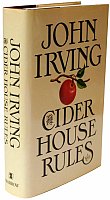The Cider House Rules by John Irving
First published in 1985, The Cider House Rules did not find the limelight until the early ‘90’s, around the time that it was made into a movie. Irving had a significant voice in the making of the movie, however he admits that a 621-page book could not easily be condensed into a 2-3 hour block. Irving felt confined by this, though was satisfied, he claims, with the overall result. Irving did regret that several important (main) characters were omitted from the film and also that a poignant 15-year period of time was compressed down to 15 months.
If one had to summarize what The Cider House Rules is about, the first word that comes to mind is abortion. However, the story has a plethora of themes of equal importance. It is a story about the circle of life, the meaning of life, the passage of time and decisions we make within that time. A cramped father/ son relationship runs the course of the book and may be a theme more prominent than abortion. This is a book about why we make the decisions we do, the actions of others that influence our decisions and how we cope with the impact our decisions have on each other and on our own psyche.
The book deals with the sorrowful lives of orphans, the minimal resources available to the underprivileged during the 1940’s and 1950’s and the deprived landscape of an ultra-rural, fictional location called St. Cloud’s, Maine. Themes of race, abuse, incest, addiction, WWII, handicap, love triangles, grief and death create a mostly somber tone. Yet, Irving does toss us, albeit conservatively, snippets of laugh-out-loud humor, amidst the anguish. In this way, our attention is held tightly and our interest in each character grows exponentially with each turn of the page.
An actual Cider House is not mentioned until page 252, more than a third of the way through the book. At times the book does feel reminiscent of Samuel Beckett’s Waiting For Godot. The reader is forced to do a lot of “waiting and seeing” alongside the characters’ own “waiting and seeing.” We wait for characters to make decisions. We wait for characters to communicate their desires, intentions and emotions to us and to each other. In short, we wait for our characters to decide whether they will decide. Page 366 summarizes this waiting game well: “If you could be patient enough to wait and see, the right thing must present itself—mustn’t it? What else does an orphan do, anyway, but wait and see?” And wait and see we do, as readers, if we want to know the final destinies of each character—revealed to us only in the final pages.
Despite the heaviness of the story, it is a stimulating read from start to finish. There is nothing hackneyed about it, nothing that has been attempted before. It stands apart as a true reflection piece. It creates an almost-glow around it that keeps readers aroused, despite Irving’s wordiness. Could Irving have said what he needed to say in fewer words? Perhaps. Or is it the tangential nature of the book that makes it radiate? Reverberate?
It is a grey book, to be sure, with lots of grey area, taking place predominantly in a grey world. However, somehow, it still manages to be luminous. It opens our eyes to new ways of thinking. Whether you are pro-life or pro-choice, you will be offered insight on a delicate subject—something that is meaningful in its own right. For this, John Irving and The Cider House Rules will go down in history as unforgettable and inimitable. On www.BananaReader.com, it was awarded a coveted 5/5 rating.


{ 0 comments… add one now }